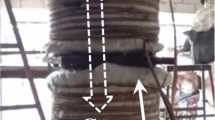Abstract
THE electrical breakdown of a gap bridged by dust deposits is frequently ascribed to the presence of the dust, bub little information on the conductivity characteristics of dust is available. These characteristics were therefore investigated for a typical sample of the following composition : volatile matter (oils), carbon, moisture, 55 per cent; metals and oxides (iron, copper, brass, iron and copper oxides), 36 per cent ; residue, complex silicates (clay), 9 per cent.
Similar content being viewed by others
References
Maurer, R. J., J. Appl. Phys., 16, 563 (1945).
Fairweather, A., J. Inst. Elect. Eng., 89 (I), 499 (1942).
Güntherschulze, A., Z. phys., 86, 778 (1933).
Fröhlich, H., Nature, 158, 332 (1946).
Dèchêne, G., C. R. Acad. Sci. Paris, 200, 648 (1935).
Author information
Authors and Affiliations
Rights and permissions
About this article
Cite this article
GOLDSCHMIDT, K. Conductivity Hysteresis of Dust Deposits. Nature 159, 815–816 (1947). https://doi.org/10.1038/159815a0
Issue Date:
DOI: https://doi.org/10.1038/159815a0
- Springer Nature Limited





